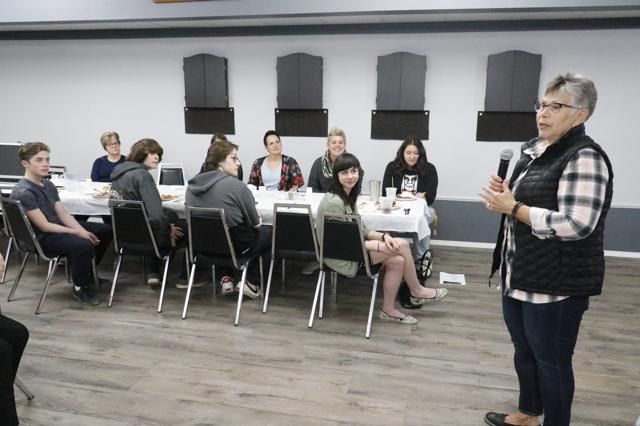The Bridge School program has helped students stay in school and finish their secondary education, and continues to help students today, members of the Rotary Club heard in a presentation on Thursday.
The club has had a long relationship with the school, as the students from the program have volunteered to help by setting up for the club’s weekly luncheon meeting in the Vimy Room at the Legion Hall every Thursday.
This began when the Bridge School was located in the basement of the old City Hall building next door to the Legion, and continued when they were located on East Avenue in the Stagecoach Bus building on East Avenue, and today as the program is now located in the Comp School.
Teacher Angie Zackrisson and Education Aide Jen Clark accompanied students from the program to the Rotary meeting to talk about how the program helps students, and what it means to them and to the students.
As funding dollars for K-12 education has been getting tighter in recent years, the Bridge School was moved into a classroom at the Comp two years ago due to the cost of having it located off-campus, said Zackrisson.
When the program moved to the Comp, she said, “we weren’t sure they would still want to volunteer to set up for the Rotary meetings, but the kids came to us and said ‘it’s Thursday, we have to go to the Legion.’”
The students set up the flags and club banner, the podium and set the tables for lunch.
Currently there are 14 students enrolled in the Bridge School program, said Zackrisson, who noted this is her third year as the teacher.
“It’s a program for students who can’t do the regular stream of classes for a number of reasons. The Bridge program is designed for them,” she explained, noting that for a number of subjects they are with the “mainstream” students. The main difference for the Bridge students is that in subjects that are divided by semester, they are able to take the entire school year to complete it.
“We slow it down and they can take the whole year to do a class,” said Zackrisson, noting this allows for more one-on-one time with the teachers.
“Since moving to the Comp, there are some positives,” she added, pointing out there are some subject she can’t teach that they can take at the Comp, such as welding, construction or cosmetology classes.
“That’s always beneficial for them to get out of the class. They take some of the electives outside of the class. It’s nice so they can bridge into the mainstream,” she said.
“What makes the Bridge unique is that we’re family. We know them, we understand them and we love them,” said Clark. “And like with a family, we laugh together, we cry together and we fight together. We want the best for each and every one of them. We do whatever it takes for them to achieve success, whatever that looks like.”
She added that the Bridge class is a safe place for the students to come, and noted sometimes even former students come by to chat with them or to ask for advice.
“It’s a small class, so we get to know the kids as kids and get to interact with them. I don’t ever want to be in a mainstream classroom, because these are our kids,” said Clark.
Sometimes slowing down the learning process might mean the students take a year or two longer to graduate, noted Zackrisson. “I truly believe some of these students wouldn’t be here without this class. There’s lots of learning that goes on, and sometimes they help me some days too.”
The Bridge School “really is a wonderful program” because there are students able to graduate who might otherwise drop out of the regular program.
“We cheer them on. It’s pretty awesome when they go across the stage,” said Zackrisson.
Two of the students, Maddy and Autumn, came up to share their views of the school.
“They’re definitely more than teachers, they’re real friends,” said Maddy.
“Without the help of these two ladies, I would not do well in school,” added Autumn. “They help you with your real life struggles, so in a way they’re closer than other teachers. They’re like our second moms, and we love them so much.”
Rotary member Bob King, who recently retired as a Comp staff member, said Clark should be considered an honourary Rotarian, as she helped out exchange student coordinator Doug Loden when he took a large group of students on their western Canada trip last year, and will be helping out again this year.
Zackrisson said the Bridge School had “a rough reputation” when it was formerly located outside of the Comp, but the program has gained much more acceptance since it relocated into the Comp building. She also pointed out there is now a waiting list to get into the program, which never happened before.
Asked how students get into the program, Zackrisson said the school administration decide whether a student fits the criteria for going into the program. She said they like to keep the class size around 14 to 16 students at the most, in order to be able to give the students the attention and help they need.



